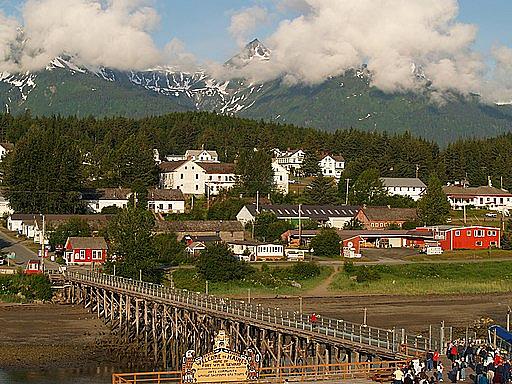How far do Alaska women have to go to give birth?

Haines, Alaska.
(Photo via Wikimedia Commons)
Imagine having to travel 100 miles by boat or seaplane for each prenatal appointment. Imagine needing to move to a city with a hospital a month before your due date because it is winter. Winter means the ferries aren’t running and the small planes that can land in your community fly only in daylight and fair weather, both scarce in winter in Alaska.
In Haines, where I live, this is the reality for women.
There is no road to the nearest hospital, there is no birth unit, there is no OB-GYN or pediatrician. While there is a hospital in Whitehorse, 250 miles away in the Yukon Territory, it has been nearly two decades since Canada permitted American women to enter the country to give birth. That road continues to Anchorage, a two-day drive over mountain passes in unpopulated territory. You would still have to pass across the Canadian border, which is closed due to the coronavirus.
Haines is not unique; access to basic women’s healthcare is limited in Alaska, especially for rural residents and Alaska native women. I’m interested in the situation as it stood before the COVID-19 pandemic and how it has intensified in the last few months. My reporting will investigate how many women in Alaska don't have ready access to prenatal care, labor and delivery services, and postpartum and pediatric care.
Roughly a third of the state’s population is considered rural and one in eleven people live in remote areas. These remote and rural areas are disproportionately poor or Alaska native communities. The state has long struggled to retain qualified medical professionals in rural areas for many reasons, according to officials. Alaska rural care providers are dogged by the same issues that plague other rural areas, with the added complications of brutal winters and isolation.
The pandemic has exacerbated the barriers to services. Significantly fewer people have plans to travel, since health officials advise hunkering down. Rural airlines have reduced schedules because there were so few passengers during a statewide moratorium on intrastate travel; Ravn Air, a key airline connecting remote villages, folded during the pandemic. The state’s ferry system, which connects remote residents in the coastal archipelago, has significantly reduced service due to state budget cuts. Some communities that are not connected to the state road system have no service at all in wintertime. It's not just that travel is harder and more stressful—money is also tighter. With an almost no summer tourism now and the loss of oil jobs, Alaska’s unemployment rate is 13%.
While my series will expose the serious challenges for rural health care, it will also be a compassionate look at the resilient women who navigate pregnancy and motherhood, and thrive, in spite of the difficulties.
